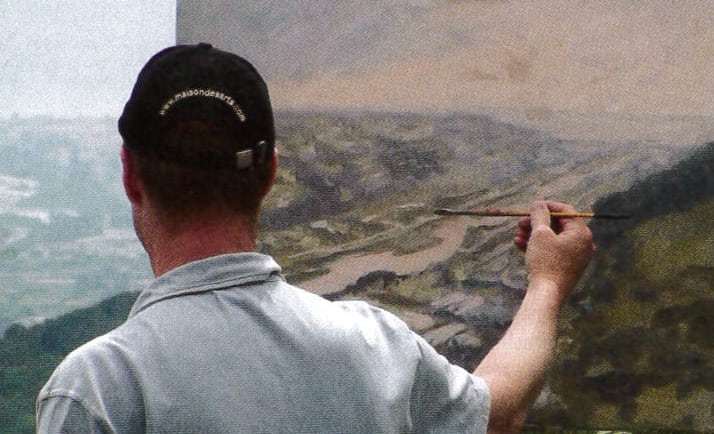
SAA PA Mitch Waite use his oil paints to capture this vista of the River Var from this hillside vantage point.
Materials:
SAA Oil Paints:
Titanium White
Raw Sienna
Burnt Sienna
Cadmium Red
Cadmium Yellow
Ultramarine Blue
Burnt Umber
Alizarin Crimson
Also:
Turpentine
Canvas
Hog Hair Brush
For this demonstration, I’ve chosen a location up in the hills near Gattière looking down on the River Var. In the distance lie Nice airport and the Mediterranean Sea. It’s a terrific view but what really struck me was the light; soft and atmospheric. I love the way the warm colours that reflect off the river and buildings in the middle ground contrast against the surrounding cooler colours.

I always stress the importance of the composition; after all the rest of the picture is built on it. You want to know what you are doing, why you are doing it and then get it right. I think about what is inspiring me, in this case, the light of the river and buildings just to the right. This is my “focus”, everything else is a “framework”, and if you can remember this it helps prevent fragmenting the picture (painting several areas of interest resulting in nothing working).
Using a lot of turpentine with just a little paint I sketch in a few lines to establish the horizon, river and the position of the hill on the right. Then still with plenty of turpentine, I mix up some subdued colours to wash in the first few blocks of colour; the sky and the hills. The main thing on my mind is getting the tonal values. I don’t want to make the sky or the distant hills too light or else the higher lights on the river and buildings won’t show.

My first objective is to completely cover the canvas so that I can see the tonal values and colour relationships. It’s very hard to judge either of these while there is still white canvas showing. I’ve seen so many people on our courses get caught up with detail at this stage. Don’t do it – resist the temptation. You will invest time and emotional energy in something that you may have to change for the benefit of the bigger picture, then you’ll be reluctant to change what you know you really should.

Once I’m reasonably happy with the tones and colours I start to define some of the shapes. I’m still not looking at detail at this stage, however, what I am interested in is the rhythm of the brush strokes – the way they start to dance around the canvas. You can see here I’ve used the darks to define the distant hill and then added some darker tones in the foreground that literally dance across the canvas. These are suggesting the flow of the trees.

With the feeling of the picture starting to work I turn my attention to the detail, starting with the dark shadows of the trees in the foreground. Mixing mainly Burnt Sienna and Ultramarine with just a little white I keep the mixture towards blue and add much more texture. Be careful when you are painting trees, not to fall into the trap of painting everything strong green. In this case, the shadows are dark grey-blue. As a general guideline, keep the greens subdued in landscapes, look to see how you can soften them with other colours. Also, try to vary the brush strokes, it’s very easy to make the mistake of repeating brush strokes too many times and creating patterns that don’t look natural.

The warm lights are what make this picture really work. The warmest go on the river and buildings in the focus area. To mix them I’ve added a little Cadmium Red and Cadmium Yellow with some white and softened with the grey colours already on my brush. As I work away from the focus I’m reducing the tonal value and mixing the lights a little cooler. These subtle changes are very important in helping to build more atmosphere.

I’m frequently asked, “How do you know when a painting is finished?” I think to know the answer to this question you must know what you set out to do. I spoke about fragmenting the picture earlier due to taking different areas and treating them individually due to a lack of focus, a lack of understanding – it is very common to over-work the picture.
Instead of seeing and experiencing the effect of the whole piece we look at individual areas and try to improve them often adding unnecessary detail. When you’ve got to the point where you are looking for something to fix – stop!
Take some reflection time and remember to go back to that emotional focus that was the reason for your picture. Then when you are seeing it in that context, make your decision as to anything that might need doing.
In this picture, I want to capture how the hazy atmosphere contrasts with the strong gash of winding warm light on the river and the catches of light around it on the buildings. It’s a picture about atmosphere and light. It’s taken me an hour to get to this point so I could easily go on, but when I look at it now it says all I want it to.